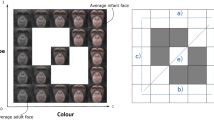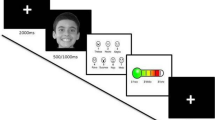Abstract
Human and nonhuman faces were shown to clinical controls, autistic, mentally retarded, and language-disordered children to assess their ability to detect and draw inferences about facial age. Children were asked to select from sets of three faces the one that appeared youthful or to select faces that would be associated with some age-related characteristic. In two studies, it was found that, relative to other children, autistic children had more difficulty perceiving youthfulness in nonhuman faces compared with human faces. These data are discussed with respect to differences in mechanisms and processes that may underlie facial information processing in autistic and nonautistic children.
Similar content being viewed by others
REFERENCES
Adrien, J. L., Faure, M., Perrot, A., Hameury, L., Garreau, B., Barthelemy, C., & Sauvage, D. (1991). Austim and family home movies: Preliminary findings. Journal of Autism and Developmental Disorders, 21, 43–50.
Alley, T. R. (1988). The effects of growth and aging on facial aesthetics. In T. R. Alley (Ed.), Social and applied aspects of perceiving faces (pp. 51–62). Hillsdale, NJ: Erlbaum.
Alley, T. R., & Hildebrandt, K. A. (1988). Determinants and consequences of facial aesthetics. In T. R. Alley (Ed.), Social and applied aspects of perceiving faces (pp. 101–140). Hillsdale, NJ: Erlbaum.
American Psychiatric Association (1994). The diagnostic and statistical manual of mental disorders, IV. Washington, D.C.: American Psychiatric Association.
Baron-Cohen, S., Campbell, R., Karmiloff-Smith, A., Grant, J., & Walker, J. (1995). Are children with autism blind to the mentalistic significance of the eyes? British Journal of Developmental Psychology, 13, 379–398.
Baron-Cohen, S., Wheelwright, S., & Jolliffe, T. (1997). Is there a "language of the eyes"? Evidence from normal adult, and adults with autism and Asperger syndrome. Visual Cognition, 4, 311–331.
Bartlet, J. C., & Searcy, J. (1993). Inversion and configuration of faces. Cognitive Psychology, 25, 281–316.
Berry, D. S., & McArthur, L. Z. (1988). The impact of age-related craniofacial changes on social perception. In T. R. Alley (Ed.), Social and applied aspects of perceiving faces (pp. 67–87). Hillsdale, NJ: Erlbaum.
Bigelow, A., MacLean, J., Wood, C., & Smith, J. (1990). Infants' responses to child and adult strangers: An investigation of height and facial configuration variables. Infant Behavior and Development, 13, 21–32.
Borkowski, J. G., & Wanschura, P. B. (1974). Mediational processes in the retarded. In N. R. Ellis (Ed.), International review of research in mental retardation, Vol. 7. NY: Academic Press, 1974.
Boucher, J., & Lewis, V. (1992). Unfamiliar face recognition in relatively able autistic children. Journal of Child Psychology and Psychiatry and Allied Disciplines, 33, 843–859.
Boucher, J., Lewis, V., & Collis, G. (1998). Familiar face and voice matching and recognition in children with autism. Journal of Child Psychology and Psychiatry and Allied Disciplines, 39, 171–181.
Capps, L., Yirmiya, N., & Sigman, M. (1992). Understanding of simple and complex emotion in non-retarded children with autism. Journal of Child Psychology and Psychiatry and Allied Disciplines, 33, 1169–1182.
Caron, A. J., Caron, R., Roberts, J., & Brooks, R. (1997). Infant sensitivity to deviations in dynamic facial-vocal displays: The role of eye regard. Developmental Psychology, 33, 802–813.
Cohn, J. F., & Tronick, E. Z. (1983). Three-month-old infants' reaction to simulated maternal depression. Child Development, 54, 185–193
Cunningham, M. R. (1986). Measuring the physical in physical attractiveness: Quasi-experiments on the sociobiology of female facial beauty. Journal of Personality and Social Psychology, 50, 925–935.
Davies, S., Bishop, D., Manstead, A. S. E., & Tantam, D. (1994). Face perception in children with autism and Asperger's syndrome. Journal of Child Psychology, Psychiatry, and Allied Disciplines, 35, 1033–1037.
Dawson, G., Meltzoff, A. N., Osterling, J., & Rinaldi, J. (1998). Neuropsychological correlates of early symptoms of autism. Child Development, 69, 1276–1285.
Ekman, P., & Davidson, R. (1994). The nature of emotion: Fundamental questions. NY: Oxford University Press.
Friedman, H., & Zebrowitz, L. Z. (1992). The contribution of typical sex differences in facial maturity to sex-role stereotypes. Personality and Social Psychology Bulletin, 18, 430–438.
Frith, U., & Happe, F. (1994). Autism: Beyond theory of mind. Cognition, 50, 115–132.
Gilliam, J. E. (1992). Gilliam Autism Rating Scale. Austin, TX: Pro-ed.
Gross, T. F. (1997). Children's perception of faces of varied immaturity. Journal of Experimental Child Psychology, 66, 42–73.
Hildebrandt, K. A., & Fitzgerald, H. E. (1979). Facial feature determinants of perceived infant attractiveness. Infant Behavior and Development, 2, 329–339.
Hobson, R. P. (1983). The autistic child's recognition of age-related features of people, animals, and things. British Journal of Developmental Psychology, 1, 343–352.
Hobson, R. P. (1987). The autistic child's recognition of age-and sex-related characteristics of people. Journal of Autism and Developmental Disorders, 17, 63–79.
Hobson, R. P. (1993). Autism and the development of the mind. Hillsdale, NJ: Erlbaum.
Hobson, R. P., Ouston, J., & Lee, A. (1988). What's in a face? The case of autism. British Journal of Psychology, 79, 441–453.
Johnson, H. H., & Morton, J. (1991). Biology and cognitive development: The case of face recognition. New York: Blackwell.
Kanazawa, S. (1996). Recognition of facial expressions in a Japanese monkey (Macaca fuscata) and humans (Homo sapiens). Primates, 37, 25–38.
Kanazawa, S. (1998). What facial part is important for Japanese monkeys (Macaca fuscata) in recognition of smiling and sad faces of humans (Homo sapeins). Journal of Comparative Psychology, 112, 363–370.
Karraker, K. H., & Stern, M. (1990). Infant physical attractiveness and facial expression: Effects on adult perceptions. Basic and Applied Social Psychology, 62, 221–230.
Keating, C. F., & Keating, E. G. (1993). Monkeys and mug shots: Cues used by rhesus monkeys (Macaca mulatta) to recognize a human face. Journal of Comparative Psychology, 197, 131–139.
Koegel, R. I., Koegel, L., & Parks, D. R. (1995). "Teach the individual" model of generalization: Autonomy through self management. In R. L. Koegel & L. Koegel (Eds.), Teaching children with autism: Strategies for initiating positive interactions and improving learning opportunities (pp. 67–77). Baltimore, MD: Paul H. Brookes Publishing Co.
Krug, D. A., Arick, J. G., & Almond, P. J. (1980). Autistic screening instrument for educational planning. Austin, TX: Pro-ed.
Langdell, T. (1978). Recognition of faces: An approach to the study of autism. Journal of Child Psychology, Psychiatry, and Applied Disciplines, 19, 255–268.
Leslie, A., & Roth, D. (1993). What autism teaches us about metarepresentation. In S. Baron-Cohen, H. Tager-Flusberg, & D. J. Cohen (Eds.), Understanding other minds: Perspectives from autism, pp. 83–111.
Lewis, M. & Brooks-Gunn, J. (1979). Social cognition and the acquisition of self. New York: Plenum.
Lewis, M., & Feiring, C. (1979). The child's social network: Social object, object functions and their relationship. In M. Lewis & L. Rosenblum (Eds.), The child and its family: The genesis of behavior. Vol. 2. (pp. 9–27). New York; Plenum.
Lockman, S., Baron-Cohen, S., Perreir, D., Milders, M., & Grow, S. (1997). Eye direction: A dissociation between geometric and joint attention skills in autism. British Journal of Developmental Psychology, 15, 77–95.
Loveland, K. A., Tunai-Kotoski, B., Chen, Y. R., Ortega, J., iet al. (1997). Emotion recognition in autism: Verbal and nonverbal information. Development and Psychopathology, 9, 579–593.
Maier, R. A., Holmes, D. L., Slaymaker, F. L., & Reich, J. N. (1984). The perceived attractiveness of preterm infants. Infant Behavior and Development, 7, 403–414.
McCall, R. B., & Kennedy, C. B. (1980). Attention of 4-month infants to discrepancy and babyishness. Journal of Experimental Child Psychology, 29, 189–201.
Montepare, J. M., & Zebrowitz, L. A. (1998). Person perception comes of age: The salience and significance of age in social judgments. In M. P. Zanna (Ed.), Advances in experimental social psychology, Vol. 30, (pp. 93–161). San Diego, CA: US Academic Press.
Nelson, C. A. (1987). The recognition of facial expressions in the first two years of life: Mechanisms of development. Child Development, 58, 889–909.
Osterling, J., & Dawson, G. (1994). Early recognition of children with autism: A study of first birthday home videotapes. Journal of Autism and Developmental Disorders, 24, 247–258.
Roder, B., Bates, C., Crowell, S., Schilling, T. et al., (1992). The perception of identity of 6 1/2 month-old infants. Journal of Experimental Child Psychology, 54, 57–73.
Schopler, E., Reichler, R. J., & Renner, B. R. (1988). The childhood autism rating scale. Los Angeles, CA: Western Psychological Services.
Sigman, M. D., Kasari, C., Kwon, J. H., & Yirmiya, N. (1992). Response to the negative emotions of others by autistic, mentally retarded, and normal children. Child Development, 63, 796–807.
Sigman, M., & Ruskin, E. (1999). Continuity and change in the social competence of children with autism, Down syndrome, and developmental delays. Monographs of the Society for Research in Child Development, 64, Serial No. 256.
Sparrow, S., Balla, D. A., & Cicchetti, D. V. (1984). Vineland adaptive behavior scale (revised). Circle Pines, MN: American Guidance Service.
Sternglanz, S. J., Gray, J. L., & Murakami, M. (1977). Adult preferences for infantile facial features: An ethological approach. Animal Behavior, 25, 108–115.
Strauss, M. (1979). Abstraction of prototypical information by adults and 10-month-old infants. Journal of Experimental Psychology: Human Learning and Memory, 5, 618–632.
Teunisse, J. P., & de Gelder, B. (1994). Do autistics have a generalized face processing deficit? International Journal of Neuroscience, 77, 1–10.
Trepagnier, C. (1996). A possible origin for the social and communicative deficits of autism. Focus on Autism and Other Developmental Disabilities, 11, 170–182.
Trepagnier, C. (1998). Autism etiology: A face-processing perspective. Brain and Cognition, 37, 158–160.
Volkmar, F. R., Sparrow, S. S., Rende, R. D., & Cohen, D. J. (1989). Facial perception in autism. Journal of Child Psychology and Psychiatry and Allied Disciplines, 30, 591–598.
Wainwright-Sharp, J. A., & Bryson, S. E. (1993). Visual orienting deficits in high functioning people with autism. Journal of Autism and Developmental Disabilities, 23, 1–13.
Walton, G. E., Bower, N. J. A., & Bower, T. G. R. (1992). Recognition of familiar faces by newborns. Infant Behavior and Development, 15, 265–269.
Waterhouse, L., Fein, D., & Modahl, C. (1996). Neurofunctional mechanisms in autism. Psychological Review, 103, 457–489.
Yirmiya, N., Sigman, M. D., Kusari, G., & Mundy, P. (1992). Empathy and cognition in high-functioning children with autism. Child Development, 63, 150–160.
Zahn-Waxler, C., Radke-Yarrow, M., Wagner, E., & Chapman, M. (1992). Development of concern for others. Developmental Psychology, 28, 126–136.
Author information
Authors and Affiliations
Rights and permissions
About this article
Cite this article
Gross, T.F. Perception of Human and Nonhuman Facial Age by Developmentally Disabled Children. J Autism Dev Disord 32, 169–179 (2002). https://doi.org/10.1023/A:1015445629062
Issue Date:
DOI: https://doi.org/10.1023/A:1015445629062




